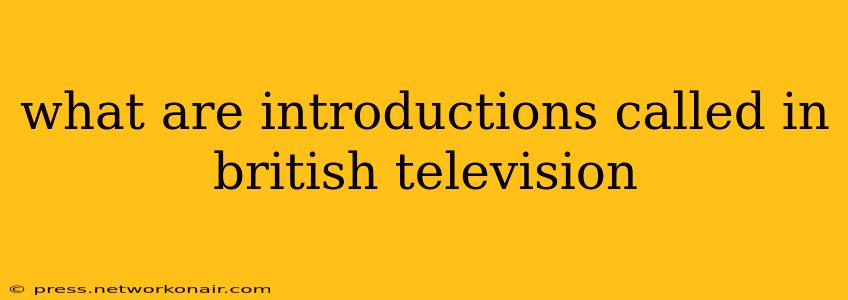What Are Introductions Called in British Television?
The term used for introductions in British television varies depending on the context. There isn't one single, universally accepted term. However, several phrases are commonly used and understood, often interchangeably:
1. Opening Titles/Sequence: This is perhaps the most common and widely understood term. It refers to the visual and audio elements that appear at the beginning of a program, often including the show's title, theme music, and a montage of clips. This encompasses more than just a verbal introduction; it's the entire initial presentation.
2. Introduction Sequence: Similar to "opening titles," this phrase focuses on the sequential nature of the opening elements, emphasizing the order in which various components appear.
3. Opening Credits: This term is frequently used, particularly for dramas and longer-form programs. "Credits" refers to the listing of personnel involved in the production, which often forms a significant part of the opening sequence.
4. Titles: This is a shorter, more concise way to refer to the opening titles or credits. It's less descriptive but perfectly understandable within the context of television discussion.
What About Verbal Introductions?
While "opening titles" typically encompasses the visual and audio aspects, the verbal introduction, if present, might be called a few different things:
- Preamble: This term might be used for a brief spoken introduction, often setting the scene or providing a brief synopsis of the episode.
- Voiceover Introduction: If the introduction is delivered by a narrator, this descriptive term applies.
- Presenter Introduction: If the host or presenter introduces the program, this is a more specific description.
Why the Variation?
The lack of a single definitive term reflects the diverse nature of British television programming. A short sitcom might have a simple, fast-paced opening sequence with minimal verbal introduction, while a historical drama might feature elaborate opening credits with a longer, more descriptive voiceover. The term used will often depend on the specific style and format of the program.
H2: What are the differences between British and American TV introductions?
While the terminology might differ subtly, the core function remains the same: to engage the viewer and set the tone for the program. However, some stylistic differences exist. British television often features more understated opening sequences, sometimes foregoing elaborate graphics in favour of a simple title card and theme music. American television often employs more visually dynamic and complex opening sequences, often using more extensive and dramatic music.
H2: How long are typical British TV introductions?
The length of British TV introductions varies considerably depending on the genre and broadcaster. Sitcoms might have very short opening sequences, lasting only a few seconds, while dramas could have longer sequences lasting up to a minute or more. There's no hard and fast rule.
H2: Do all British TV shows have introductions?
While most British TV shows have some form of introduction, some, particularly shorter programs or those with a very specific format, might omit elaborate opening sequences. The style and presence of introductions depend entirely on the creative choices of the program makers.

